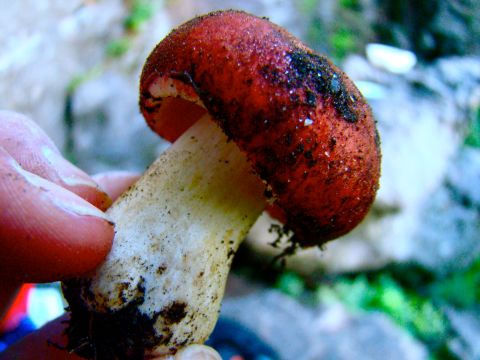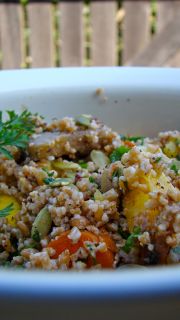Sprouted Buckwheat & Date Granola
August 9, 2012 § 3 Comments
Crunchy granola. Yes, crunchy granola is right and in more ways than the one mind-blowing, muscle powering, tongue tantalizing way I’m about to share with you. This recipe basically defines crunchy granola in the flowing floral skirts, worn sliver jewlery, kombuch brewing, feathers and fern trees, Dr. Bronner’s castile soap, mung bean sprouting, beeswax boiling, make love not war, downward-facing dog kind of way. This buckwheat granola was my best friend during my mountain and rock climbing excursion through New Hampshire.
While we are on the topic; I Googled “crunchy granola” and was so amused (maybe a bit too much) by the Urban Dictionary definition of “crunchy granola bar” that I felt it completely necessary to share so you can use it to spice up your everyday vernacular.
Heidi: “Oh that Crunchy Granola Bar? I heard he just moved here from Denver.”
Hiking and rock climbing with two crunchy granola bars is not easy, so I made a huge batch of raw sprouted, vegan (if you omit the raw local honey) buckwheat granola and figured it would be the best fuel (screw over-processed power bars) to power my butt up the mountain as fast as my boyfriend and his friend. And I must say, it worked very well. Not only did we make it up Mount Washington, but we completed the ascent, which usually takes about 4 hours, in only 2 hours and 40 minutes (including our granola eating breaks). I was impressed.
Since the “crunchy granola bars” I was hanging with both spend most of the year in the mountains of Arizona and Colorado, they are into rock climbing. Because Rumney, NH has some good spots to climb, we spent our last day there so they could remedy their climbing craving. So, for the first time I climbed outside, and have to say, it was a lot of fun – but again, without my sprouted granola I probably would not have been able to keep up and complete all the climbs that they did!

After leading the climb so I could top rope, Shann decided try a route that was unconventional before he cleaned the route.
Between climbs I came across some pretty cool looking mushrooms but decided to stick with eating the granola. I don’t think hallucinating is smart while rock climbing but what do I know? Anyways, let’s talk about this granola. Buckwheat is a serious power food. Not only is it gluten-free, but it also, according to Journal of Agricultural and Food Chemistry, may help to lower blood glucose levels which allow those who enjoy it to stay satiated while managing and preventing diabetes. Plus, buckwheat is high in fiber, flavonoids and minerals such as magnesium. These mirconutirents harmonize to synergistically lower LDL (low density lipoproteins aka bad cholesterol) and increase HDL (high-density lipoproteins aka healthy cholesterol). Almost as impressive as our Mt. Washington ascent, huh?

This is a pretty common edible mushroom called Hen of the Woods or Maitake which is found on or near dilapidated oak trees.
Sprouted Buckwheat & Date Granola
3 1/2 cups raw buckwheat*, 25 large Medjool dates, 1 cup water, 2 Tbsp organic extra virgin coconut oil, 2 Tbsp raw honey (optional), 1 Tbsp organic vanilla extract, 1 tsp Himalayan pink salt, 2 Tbsp Ceylon Cinnamon, 2 cups whole raw nuts (almonds, pecans or cashews), 1 cup unsweetened coconut flakes
*the amount will increase after sprouting because the buckwheat will hold water
Optional Additions: Flax seeds (raw or sprouted), crystallized ginger, dried Turkish or Black Mission figs, dried bananas, seeds, cacao nibs or beans, etc.
To Sprout: Rinse the buckwheat in a sieve, then put it in a baking dish or bowl fully submerged in water. Let the buckwheat sit in the water for 1 hour. After an hour, pour the buckwheat back into the sieve and cover with plastic wrap. Let sit for 24-48 hours (depending on how sprouted you want them) rinsing every 12 hours. When you begin to see the “tails” you can make the granola.
Date Paste: In a blender, combine 18 dates, the water, coconut oil, honey (if using), vanilla and pink salt until they for a somewhat smooth paste. Taste and adjust adding more dates, honey or vanilla depending on your preferences.
Meanwhile, chop up the remaining dates into fourths. Mix dates, nuts, coconut and cinnamon into the sprouted buckwheat. Add the date paste making sure to scrape every last drop from the blender into the buckwheat mixture.
To “Dehydrate”: Set your oven to 125 degrees Fahrenheit. Line 2 baking sheets with parchment paper and lightly coat with coconut oil. Split the buckwheat mixture into two and evenly press it out on to the baking sheets. Dehydrate for 10 to 24 hours until the date paste is dry and the buckwheat forms sheets or clusters.
Note: My oven takes about 20 hours set on the “drying” setting, but every oven will be different depending on the setting and the heat. If you have a dehydrator, set to about 110 degrees Fahrenheit and dehydrate for 3-6 hours flipping the granola over after 1.5-3 hours.
Enjoy in yogurt, tossed into a kale salad (my favorite), with some fresh figs or berries, on a peanut butter banana, in nut milk or just straight up in big handfuls! Be careful though, this stuff is addicting…. and crunchy!
P.S. for more on sprouting check out this old post or this recipe.
Kale & Roasted Raisin Jumble
November 17, 2011 § 1 Comment
Toasted fennel seeds, chewy roasted raisins, slightly charred red onion & of course the indispensable winter green, kale.

Now don’t go turning up your nose saying I’ve tried kale, I hate it & everything about it, or the infamous I’d cook that but my husband & kids will kick me out, because there is a secret to eating kale – actually, it’s a secret to harvesting kale. Kale harvested after a frost is much sweeter & more palatable than summertime kale. All it takes is a little chill & kale is transformed almost as much as a scrawny young girl after puberty – I’m not kidding. It’s probably best if I leave out the fact that it’s high in calcium, beta-carotene, lutein, vitamin C, vitamin K, sulforaphane, a molecule in all cruciferous & brassicas vegetables that is known for it’s anti-cancer properties & a plethora of various other carotinoids, at the risk that you’ll think I’m just trying to convince you to eat it. I’m not though, I promise. Skip the kale & their will be more for me.

Fennel seeds change from a muted green to a brilliant golden after being heated. Their licorice-like aroma will enhance salads, breads & cookies.
This recipe may seem like it has some tediously skip-able steps, like toasting the fennel or baking the raisins, but I assure you that they are there for a reason. Toasting the fennel seeds allows for a multi-sense experience. As the volatile oils are released, we are able to not only enjoy the flavor of the seeds, but also enjoy the aroma. The raisins are heated to further concentrate the sugar simple sugars, glucose & fructose, as heating is just a way of drawing out more water.

Maybe I'm bias because I'm sitting here eating this, but this picture does no justice to the flavor combinations in this dish.
Kale & Roasted Raisin Jumble
- 8 large leaves of kale, stemmed & chopped
- 2 red onions, sliced into 1/4 inch thick rings
- 1 cup of any grain, or pasta*
- 1/2 cup of walnuts
- 1/3 cup of raisins, roasted
- 4 Tbsp fennel seed, toasted
- 2 Tbsp olive oil
- 1 tsp coriander
- 1 tsp garlic powder (garlic salt)
- 1/4 tsp black pepper & salt to taste
*Here I used sprouted bulgur wheat, but quinoa, amaranth, barley, linguini, orecchiette, etc will do. Sprouted bulgur is cooked in the microwave with 1 cup of bulgur to 2 cups of water, covered well, for 10 minutes.
Preheat the oven to roast (or bake) at 350 degrees Fahrenheit. Add onions to a skillet over medium heat & saute for about 10 minutes, until soft. Add 1 Tbsp of olive oil, cover the onions for 2-3 minutes & allow them to brown without burning. Meanwhile, prepare what ever grain or pasta you’ve chosen to use. In a small baking dish mix the raisins & black pepper. Roast for 7 minutes, until the raisins swell slightly, then set them aside to cool.
Add chopped kale and 1 Tbsp of olive oil to the slightly charred onions and toss in the saute pan until the kale has wilted, but is still a vibrant green. Add the coriander & garlic powder. Continue to saute over low heat. Add the bulgur (or other grain) & walnuts, then salt to taste. Last, add the raisins & toss one more time.
Serve hot or refrigerate immediately. This will last refrigerated for about 5 days.
Enjoy.
Wheat Berry Sumac Salad
October 2, 2011 § 3 Comments
Sumac is not poisonous, well some varieties are, but this lemony seasoning certainty isn’t. In fact the sumac I used was given to me by my boyfriend’s mother. Her husband just returned from visiting family in Israel & brought back with him lots of the spices his family uses in their everyday cooking. I am lucky enough to be a recipient of some of those authentic spices, so I figured I’d share with you.
Sumac can be described as sour. It is native to the Middle East & is used widely there & in the Mediterranean to season meat, fish & vegetables. I’ve been putting it in everything; in hummus, on top of salads & sprinkled on my pesto salmon (a recipe Shann taught me). Sumac works so well in this fall salad, as it does add an unexpected tang to the otherwise standard grain-vegetable dish.
This wheat berry salad is relective of the colors of Autumn & the vegetables it gives us. The pepitas, translated little seed of squash, with their robust, almost chewy texture, simple flavor & sophisticated nutritional profile are a must. Actually, according to the Journal of Agricultural and Food Chemistry the phytosterols that occur in many nuts & seeds can help to naturally lower LDL (undesirable cholesterol). Pepitas, have about 265mg/100g (100 grams is about 3oz) – pretty impressive for the inside of a pumpkin seed.
Now, if you are wondering where the sprouting part comes in, listen up. The wheat berries I used were sprouted when I bought them, but you could certainly use bulgur wheat, barley, or un-sprouted wheat berries as the grain for this salad. I used the sprouted wheat berries by Shiloh Farms & because sprouting does enhance the nutritional benefits of many foods, I do recommenced you try to find them (try your local health food store).
Wheat Berry Sumac Salad
2 cups of sprouted wheat berries, 1 1/2 cups parsley, any variety, chopped, 3/4 cup pepitas, 3 large carrots, roasted, 1 delicata squash, roasted, 2 small eggplants, 3 tomatoes, 1 large white onion, chopped, organic refined coconut oil, cold pressed, 5 Tbsp extra virgin olive oil, 2 Tbsp sumac, 5 sun-dried tomatoes, crushed into a grainy powder, 1 tsp garlic powder, sea salt, black pepper & lemon juice
Bring 5 cups of water to a boil, then remove from heat. In a seperate bowl, cover the wheat berries with 4 cups of the boiling water & let them sit for an hour, or until they are soft enough to eat. If there is extra water that has not been absorbed by the wheat berries, strain the berries in a sieve. Refrigerate until ready to use.
*If you are crunched for time, this can be done it the microwave. Place 2 cups of wheat berries & 4 cups of water in a microwave safe bowl. Cover the bowl with a paper towel & a layer of plastic wrap. Microwave for 10 minutes. There should not be any extra water when finished.
Preheat oven, on roast, to 400 degrees Fahrenheit. Cut delicata squash in half & take out the seeds. On a baking stone drizzle whole carrots & delicata with 2 tablespoons of olive oil. Roast for 15 minutes. Meanwhile, sauté onion, eggplant & tomatoes in coconut oil for about 15 minutes over medium high heat until caramelized. Add 1 Tbsp sumac, salt, pepper, garlic powder & sun-dried tomatoes & sauté over low heat for 5 minutes. Remove vegetables from heat & mix them into the prepared wheat berries.
Chop parsley & add it to the wheat berry mixture. Cut the roasted carrots into 1/4 inch thick rounds & the delicata squash into cubes, then add them as well. Add the remaining 3 tablespoons of olive oil, pepitas, sumac & some salt to taste. Spritz with lemon juice & refrigerate until ready to serve. Before serving sprinkle with some sumac.
Bon appetite!












